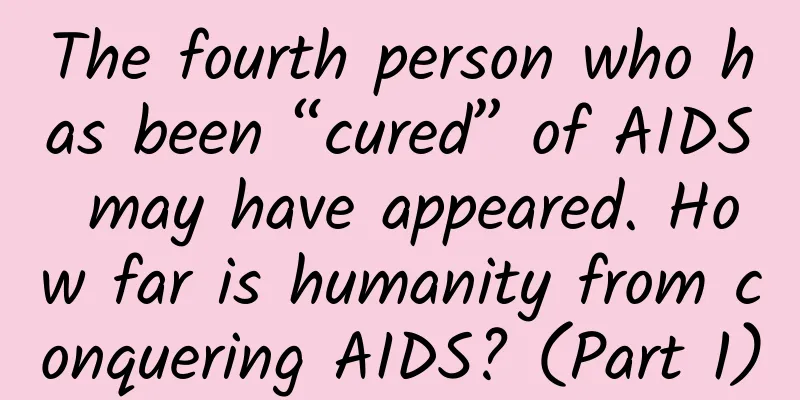The fourth person who has been “cured” of AIDS may have appeared. How far is humanity from conquering AIDS? (Part 1)

|
Produced by: Science Popularization China Author: Lu Xiuyuan (Researcher at Osaka University's Immunology Research Center) Producer: China Science Expo Recently, according to a research report, a 66-year-old leukemia patient has achieved long-term remission of AIDS after receiving a stem cell transplant, or has been "cured", becoming the fourth AIDS patient in the world to be declared "cured". This is the fourth case of AIDS being cured through stem cell transplantation after the "Berlin Patient", "London Patient" and "New York Patient", and is also the oldest patient at present. “Once infected, you have to take medicine for life”, why is HIV so difficult to cure? If we talk about the biggest nightmare in human public health in the 20th century, AIDS is definitely a strong contender. Since the U.S. Centers for Disease Control and Prevention reported the first case of HIV infection in 1981, nearly 40 million people have died from the disease. Although, compared with the droplet, contact and even aerosol transmission routes of coronavirus and influenza virus, HIV, which can only be transmitted through blood, mother-to-child and sexual contact, does not seem to be able to cause trouble. But the current situation is that the medical community has been battling this cunning virus for nearly 40 years and has barely managed to achieve a draw: existing medical methods can only use drugs to suppress the virus in HIV-infected people to a low level, keeping carriers healthy and non-infectious. Currently, there are still nearly 40 million HIV carriers in the world. Even if their life expectancy is no different from that of normal people with drug intervention, there is currently no way to completely eliminate the HIV virus in the patient's body, which means that a cure in the medical sense is still a long way off. Why is AIDS difficult to treat? We need to first understand how HIV attacks the human body. Any virus that wants to enter a cell to engage in destructive activities must have a corresponding protein that can bind to the cell surface molecules. Figuratively speaking, it is like holding a "key" that can open the "lock" on the cell surface before it can enter the cell. This also explains why the human body has different symptoms when infected by different viruses. For example, the cold virus easily infects the respiratory epithelial cells and often causes respiratory symptoms, while the rabies virus attacks nerve cells and causes brain damage, etc. HIV infects human cells through a glycoprotein molecule called CD4. CD4 molecules mostly appear on the surface of helper T (Th) cells, which are a very important part of the human immune system. They can promote the activation of killer T cells and B cells by secreting cytokines and other means, and guide the immune system to eliminate pathogens. When HIV first infects the human body, the immune system is able to fight it off. However, the insidious thing about HIV is that the Th cells infected by it will be eliminated by the cytotoxic T cells, which in turn weakens the immune response. This vicious cycle not only makes the immune system unable to eliminate HIV, but also makes it unable to resist the invasion of other pathogens. Ultimately, the immune system of the infected person will be completely destroyed, and most AIDS patients will die from complications caused by other infections. CD4 molecular structure on the surface of Th cells, source: public domain In addition to the insidiousness of attacking the human immune system, HIV, as an RNA virus, can also convert its own genetic material into DNA and insert it into the human genome. When humans use drugs to inhibit the synthesis of the virus, HIV hides in the genome of the cell under an assumed name. Once the drug is withdrawn, HIV will revive and re-synthesize virus particles to continue to infect healthy cells. This is why, even though we have developed drugs to inhibit HIV, the rule still remains “once infected, you have to take medicine for life.” From the "Berlin Patient" to the "City of Hope" The cured patient was treated at the City of Hope Medical Center in Duarte, California, U.S. Because he did not want to reveal his name, he was called a "City of Hope" patient. In the nearly 40 years since AIDS infected humans, the first person to be cured was the "Berlin patient," a miracle. So how did humans take the first step to cure AIDS? How was the first case of AIDS cured? Please stay tuned for follow-up. References: https://mp.weixin.qq.com/s/KngdehInM8WzGVKVG7ZXxg https://www.nytimes.com/2020/03/09/health/london-patient-hiv-castillejo-takeaways.html "Long-termcontrolofHIVbyCCR5Delta32/Delta32stem-celltransplantation".TheNewEnglandJournalofMedicine.360(7):692–98. |
<<: Is heart stent a technology that has been eliminated abroad? Rumors, debunked!
Recommend
The best time to take medication for medical abortion
Artificial abortion is a common phenomenon in our...
What are the benefits of eating sea cucumber for women?
Sea cucumbers are rich in collagen, which is very...
What are the effects of labia asymmetry?
For girlfriends who pursue perfection, if they fi...
How long do you need to rest after you abort your child?
With the development of society, people's min...
What should I do if my right breast has low echo
We all know that breasts are the most representat...
I have brown discharge again after more than two months of giving birth.
There will be some secretions and lochia at the b...
What are the white spots on nipples?
Breasts are something women are proud of because ...
35 weeks pregnant vaginal pain
A woman's body becomes very sensitive after s...
Symptoms of thoracic scoliosis in women
Thoracic scoliosis refers to a spinal deformity i...
What is the cause of high ferritin in pregnant women?
If a pregnant woman has high ferritin levels, she...
What is the cause of pain on both sides of the hip bone?
All diseases cause the human body to suffer certa...
How much does the Huawei Mate X5G foldable screen phone cost? Where can I buy it? When will the Huawei Mate X go on sale?
Speaking of Huawei Mate X5G foldable screen mobil...
What is the cause of chest pain and hard lumps?
Chest pain and lumps mainly consider the followin...
What causes frequent urinary incontinence in women?
Adult women will feel very embarrassed if they ha...









